April 27, 2017
Retired elementary school teacher Pam Bunderson listened intently during the April 2016 LDS General Women’s Conference, moved by General Relief Society President Linda K. Burton’s plea for help on behalf of more than 60 million refugees throughout the world.
“(She) said there are so many refugees … in the world, and that they need a friend,” Bunderson said. “They need someone who can help them learn the language, help them understand the culture, help them get situated — and it just tugged on my heartstrings.”
Bunderson wasn’t the only one touched by Sister Burton’s words. Refugee service organizations throughout the Salt Lake Valley were overwhelmed with the response of hundreds of members of the LDS Church who enthusiastically answered Sister Burton’s call to serve.
By the numbers
International Rescue Committee Utah development coordinator Jesse Sheets said there was immediate outreach to the organization following the April 2016 General Conference. He said the agency received 300 emails during the first week after the conference and 1,000 total inquiries within two weeks.
“We’ve definitely seen stupendous growth in the number of volunteers, a lot of it due to the fact that refugees are in the news and in the forefront, but also because there was a call to action,” Sheets said. “The LDS Church putting out a call to action galvanized a lot of people in the community to take action and to find ways to support, and I think that also helped spread the word to other communities.”
“The LDS Church putting out a call to action galvanized a lot of people in the community to take action and to find ways to support, and I think that also helped spread the word to other communities.” Jesse Sheets, International Rescue Committee Utah Development Coordinator
Andrea Cox, development director for the Asian Association of Utah’s Refugee and Immigrant Center, said the center’s in-kind donations have tripled since the April 2016 General Women’s Conference. She said the center’s average of 90-100 volunteers in May 2016 has now increased to 250-300 ongoing volunteers.
“We’ve seen a huge influx of people reaching out to the agency I believe because of that,” Cox said.
The Refugee and Immigrant Center also saw an increase in volunteer requests in the months following the April 2016 General Conference, according to Alisa Broadbent, a volunteer coordinator who was hired in April because of the influx.
“The week after Women’s Conference in October, we had probably three times more volunteers ask to help than we usually do,” Broadbent said.
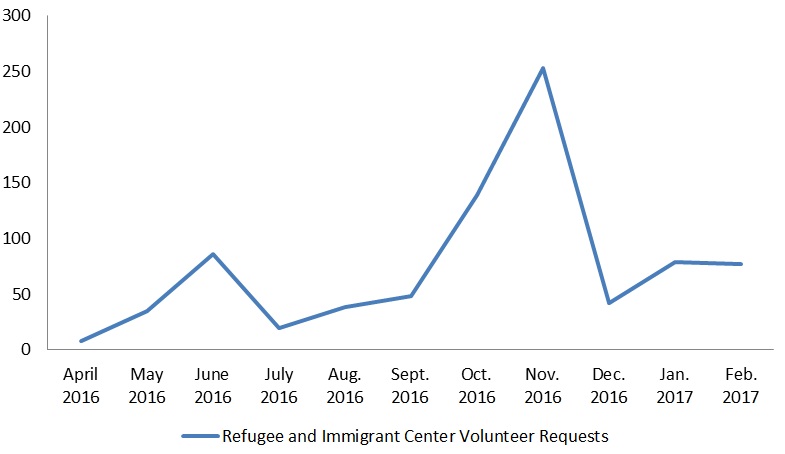
Data from Alisa Broadbent, volunteer coordinator for the Asian Association of Utah’s Refugee and Immigrant Center, shows the number of volunteer requests the center received increased in the two months following the April 2016 LDS General Conference, and then again from September to November. (Sarah Averett Harris via Microsoft Excel)
Broadbent said it’s hard to know whether the Refugee and Immigrant Center’s volunteers are Mormon because the organization does not ask its volunteers about their religious affiliation, but she would say a good amount of them are from her experience.
“I’m a member of the church, and it makes you re-evaluate how much influence our leaders have,” Broadbent said. “If they suggest something, we really take it to heart and we want to do it, and it’s not just a passing thing. So that’s been inspiring to me, just watching the members really take this to heart and follow what our leaders have asked us to do.”
“You say 'refugee' and people are all ready to help." Alisa Broadbent, Refugee and Immigrant Center Volunteer Coordinator
Broadbent said she attributes the peak in volunteer requests in October and November 2016 to interest in volunteering with the center’s Sub for Santa program during the holidays, in which 71 groups provided Christmas gifts for 270 families. She said most, if not all, who reached out during this time were members of the LDS Church.
“You say ‘refugee’ and people are all ready to help,” Broadbent said.
Volunteers at the Salt Lake City English Skills Learning Center said they also saw an increase in interest to serve refugees in their organization following the April 2016 LDS General Conference.
The center’s training sessions, which rarely averaged more than 16 people in attendance before April 2016, have filled up consistently ever since at a max of 24 volunteers per training session, according to Kristen Crummett. Crummett began volunteering at the center two months prior to the LDS Church’s announcement, in February 2016.
“From that day, there has been a marked difference in our volunteer interest,” Crummett said. “It’s sometimes overwhelming because it was very different from the amount of interest that we had before, but it’s been pretty consistent, and it’s wonderful seeing people getting involved in that way.”
“This unprecedented involvement has allowed us to reach more people in more countries." LDS Charities 2016 Annual Report
The church’s “I Was a Stranger” website, which moved forward the call to serve refugees, counted 89,000 uses of the hashtag #iwasastranger about a year after its initiation on March 26, 2016, according to the Deseret News.
Volunteers gave 942,127 hours of service in 2016 to LDS church welfare programs, many of which supported refugee causes, according to the 2016 LDS Charities Annual Report. The report accounts for the completion of 488 projects in 54 countries during the year.
“This unprecedented involvement has allowed us to reach more people in more countries,” the report states.
Other influences
Utah International Rescue Committee volunteer coordinator Kayla Norman said the media’s representation of refugees has raised awareness about their situation and increased interest in serving refugees because volunteers can help locally and make a global impact. But she said many reasons for volunteer involvement also stem from the current administration’s stance on immigration and resettlement.
Utah State Refugee Coordinator Gerald Brown said along with the LDS initiative in April 2016, the change of administration at the federal level provoked an increased interest in serving refugees.
Consequences
The church’s “I Was a Stranger” initiative encouraged members to get involved in serving refugees by volunteering with local government resettlement agencies and nonprofits. Many of these organizations in the Salt Lake Valley had to make some big adjustments in an attempt accommodate the requests, including the English Skills Learning Center, according to volunteer coordinator Jessica Hercules.
“We have had to adapt as an organization by thinking of new ways volunteers can help us,” Hercules said.
“We have had to adapt as an organization by thinking of new ways volunteers can help us." Jessica Hercules, English Skills Learning Center Volunteer Coordinator
Broadbent said she has found it taxing to reorganize the volunteer infrastructure at the Refugee and Immigrant Center in order to accommodate the increased interest, as well as to train and manage new volunteers.
“It’s great, but it’s also a burden just because we don’t have enough funding to support the amount of volunteers that are asking to help,” Broadbent said. “From my end, there’s a real desire to meet every volunteer’s needs. If there’s a skill that a volunteer has, I want to find a place to match that up, and there’s not always a place to do that. That’s a challenge.”
Catholic Community Services Public Relations and Marketing Director Danielle Stamos said her organization has likewise struggled to find a way to accommodate the number of people interested in volunteering to serve refugees.
“That’s been a challenge is just fitting everyone in because we don’t want to say no to anyone because we always need so much help,” Stamos said.
Broadbent said there was such a huge interest in volunteering with the Refugee and Immigrant Center’s Sub for Santa program that the center had to turn away about 200 people because there were more volunteers willing to help than people in need.
The International Rescue Committee also quickly ran out of volunteer positions to fill as a result of the influx, and has since shifted its focus to holding information sessions. The sessions are focused on educating those interested in volunteering about who refugees are and the work the International Rescue Committee does, encouraging those who attend to become advocates for improving the situation of refugees.
Norman said the interest in serving refugees has been so great that the waitlist to attend these sessions has included as many as 480 people.
Benefits
On the other hand, the influx of refugee service volunteers has allowed these organizations to accomplish their goals by filling all available volunteer positions and meeting in-kind donation needs.
Sheets said because of the added interest in serving refugees, the Utah International Rescue Committee was able to give refugee families more than $90,000 in in-kind donations during their “Light One Candle” Christmas drive to fulfill holiday wish lists for newly arrived refugees.
“The work that we do is impossible without volunteers,” Sheets said. “There are so many things that we do on a daily basis that even though we have 70 staff on board, we don’t have the capacity to finish all of these things and to provide all of the services for the approximately 1,100 refugees that we serve on an annual basis.”
“The work that we do is impossible without volunteers." Jesse Sheets, International Rescue Committee Utah Development Coordinator
Norman said the Utah International Rescue Committee has been able to fill more specific needs as a result of the larger pool of volunteers.
“When you have a larger audience of people that are interested, there’s more of a chance for us to actually pair someone with a relevant skill set to specific needs that come up,” Norman said. “It’s amazing. I’ve never worked in a field where we’ve had this amount of support.”
Broadbent said there are some programs at the Refugee and Immigrant Center that can’t even run without volunteers. In this way, having more volunteers means the center can help more refugees.


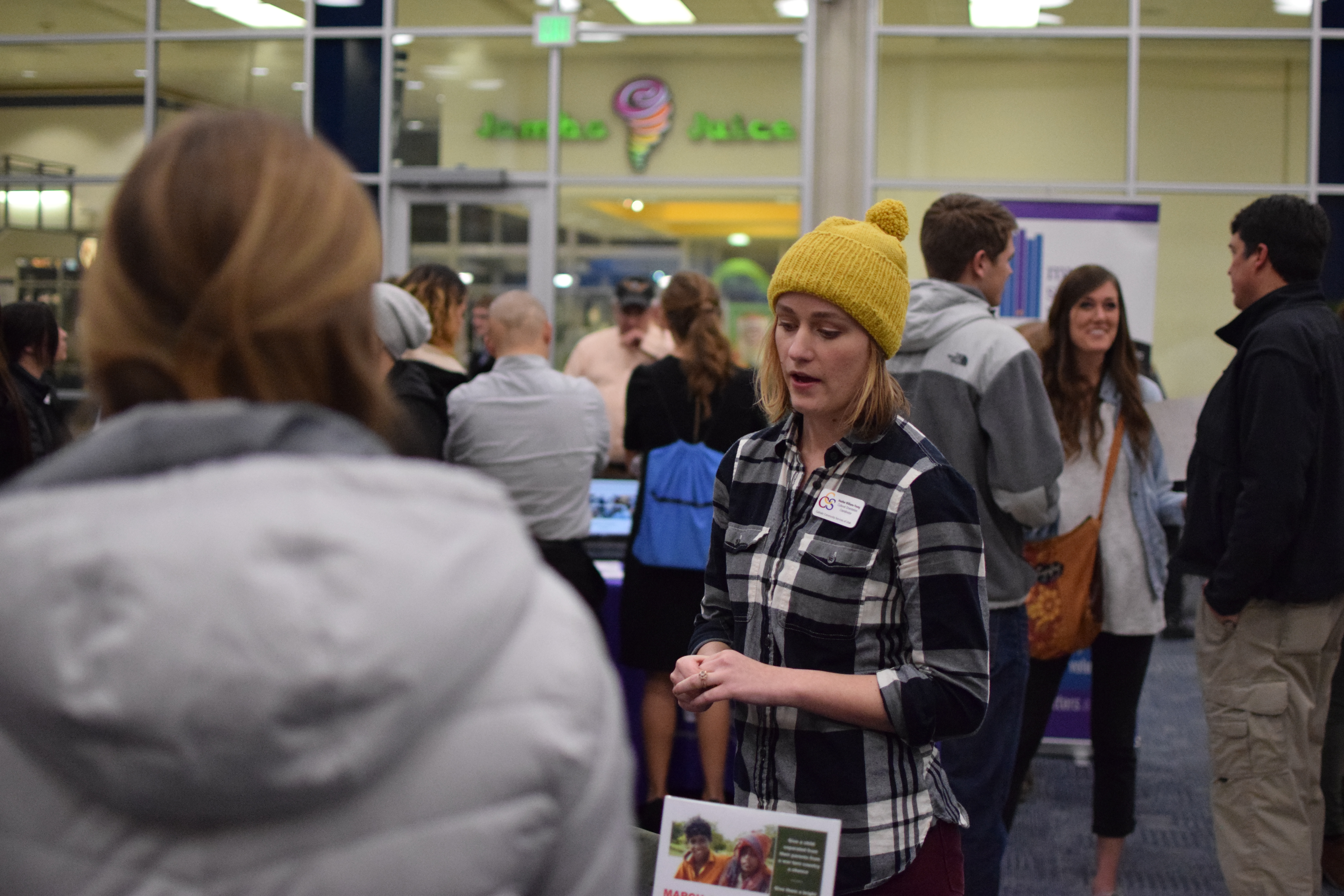

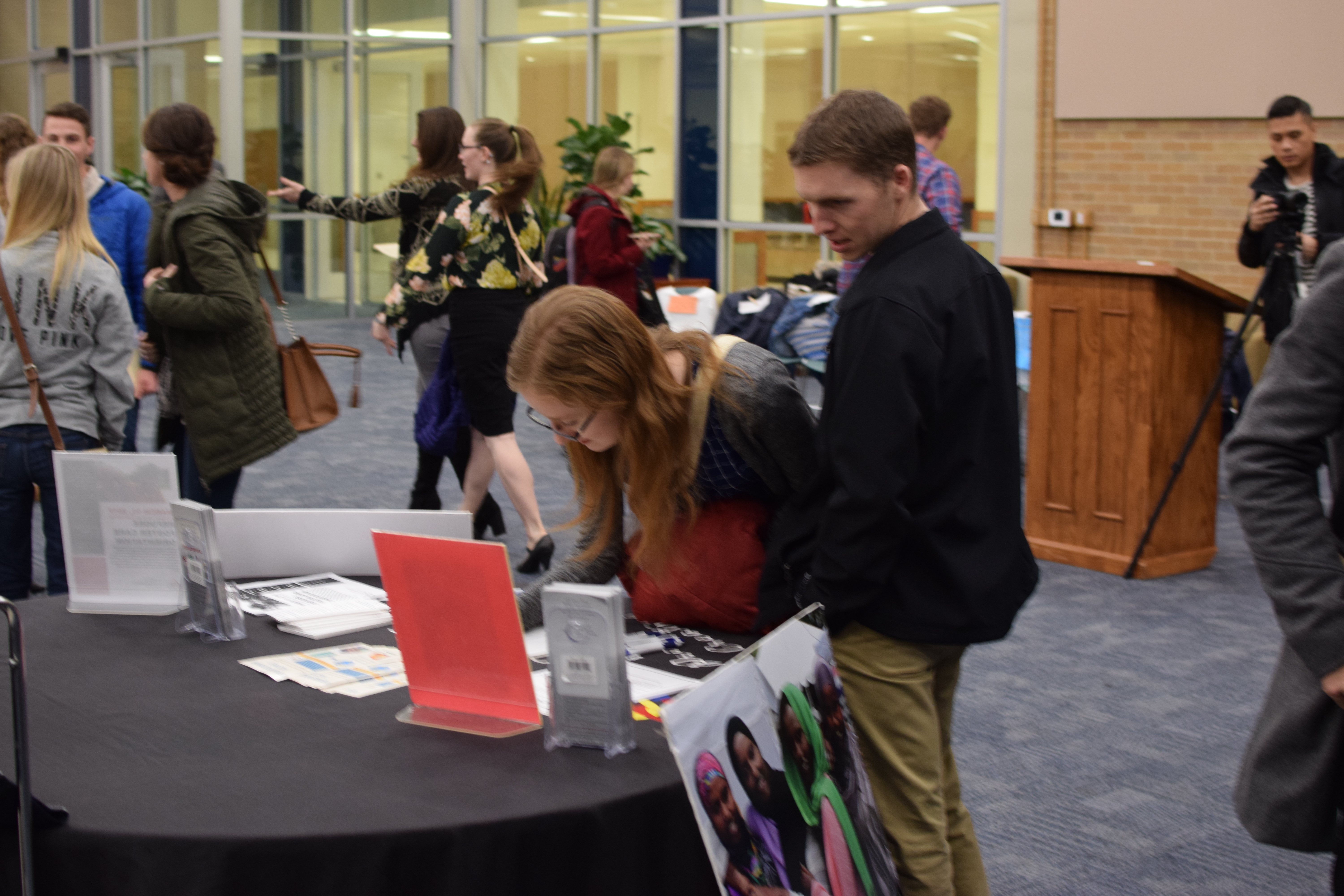
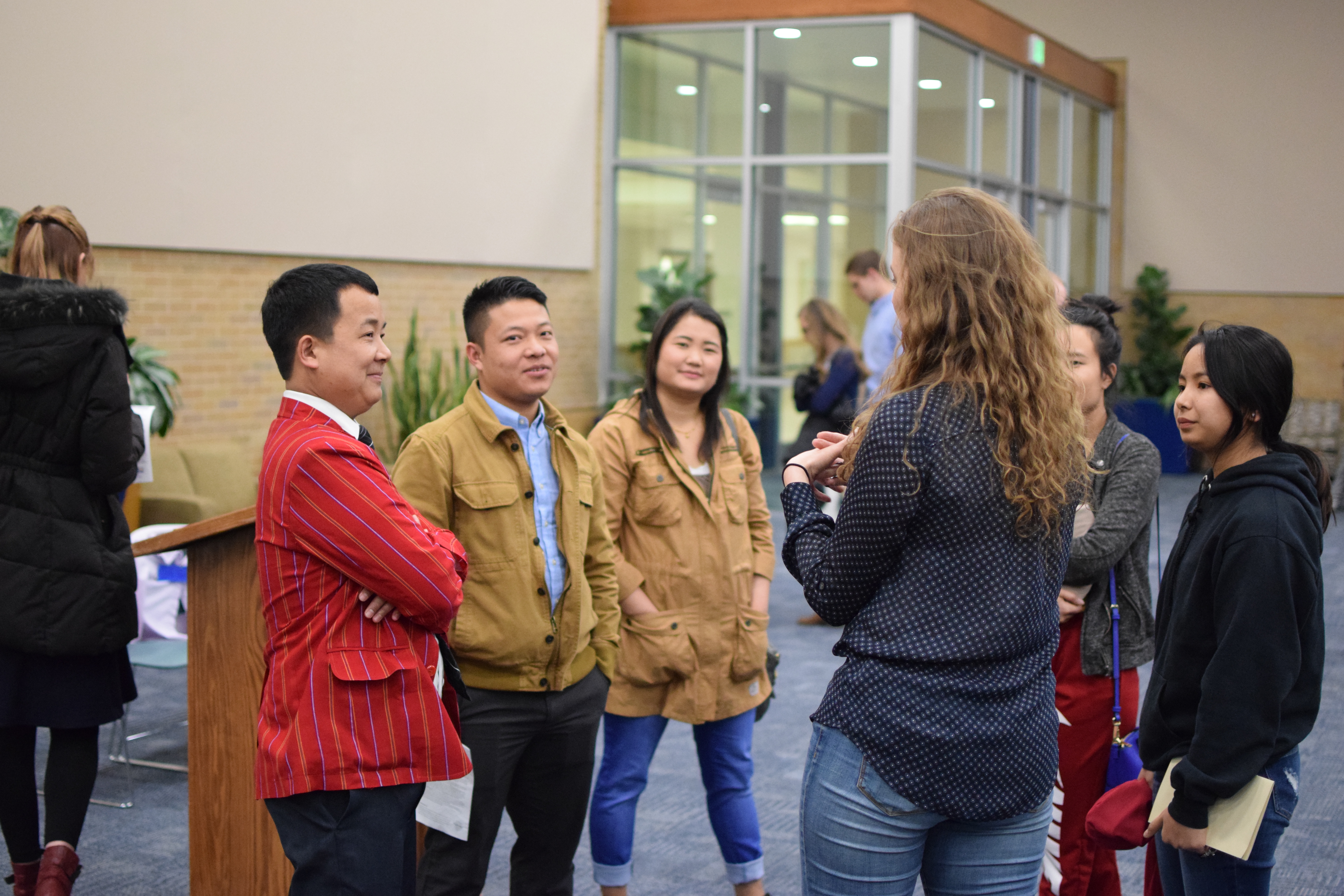

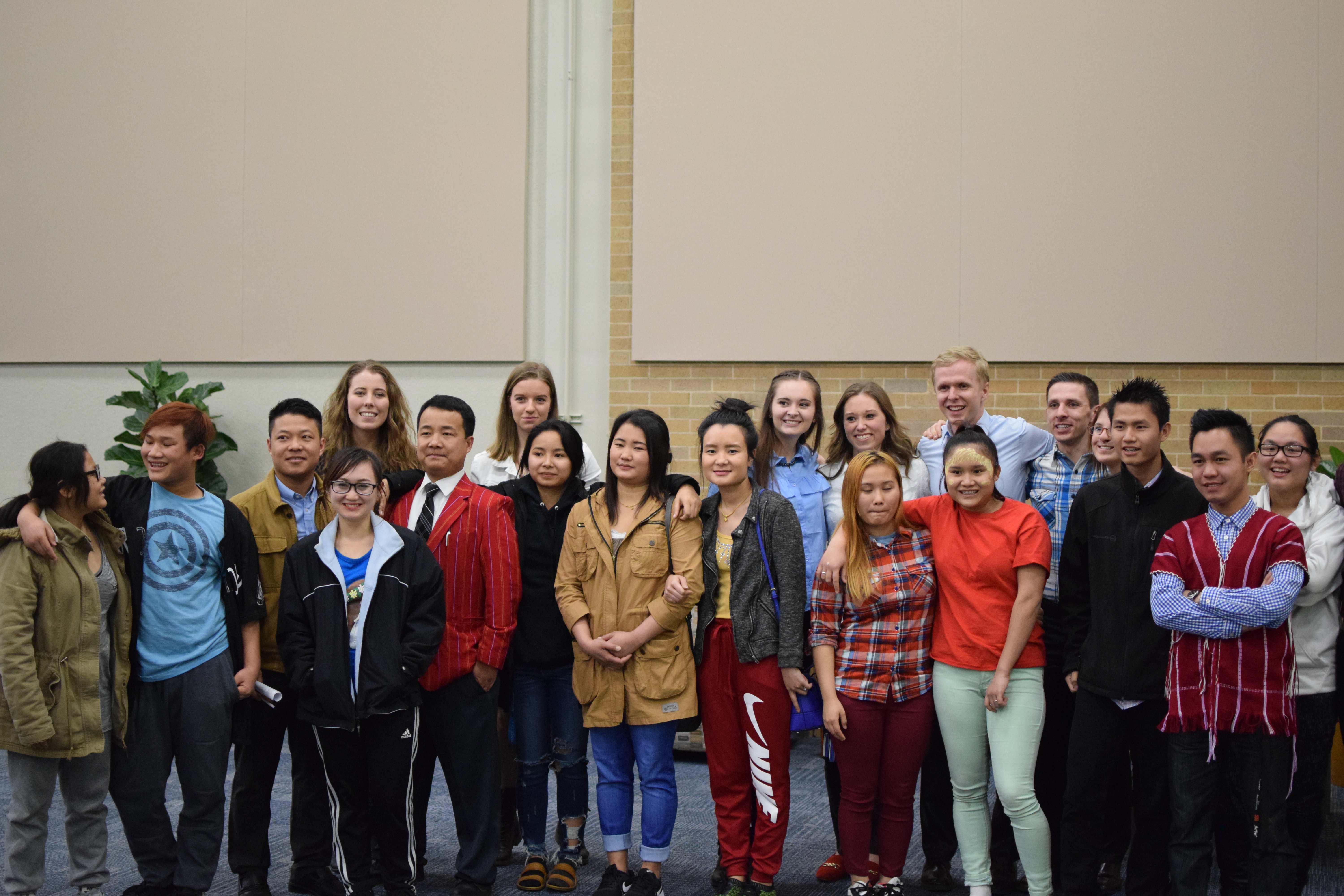
Cox said volunteers make a big difference at the Refugee and Immigrant Center, and that having volunteers saves the agency $17,000 a month.
“It’s a good problem to have,” Cox said. “It’s really been beneficial to the agency to have these volunteers that are committed and who add capacity that we just don’t have — that we can’t afford to have — so having them in after school or assisting our ESL classes really helps our paid staff to run a high-quality program.”
The volunteers also have a positive influence on the refugees, Cox said. She said students at the Refugee and Immigrant Center have a 3.0 GPA average and 85 percent average attendance rate in school, which the volunteers have helped with.

A Catholic Community Services volunteer, center right, leads a cultural orientation class with a group of newly arrived refugees. (Danielle Stamos)
Brown said volunteers are also fundamental in the integration part of refugee resettlement.
“I think volunteers are really important because the goal is to help refugees integrate into the new community,” Brown said. “You can’t have integration unless you have volunteers that are willing to mix with, communicate with, work with, do stuff with refugees.”
The increased interest in serving refugees has also been a benefit to the community in educating a larger population about what the needs and the resettlement processes are for refugees, Stamos said.
“Before this became such a focused political issue, not very many people knew about what refugees were or what the process was,” Stamos said. “And even now, it’s so difficult to educate people on what the truth is and what’s happening because there’s so much rhetoric out there. So it’s been a really wonderful opportunity for us.”
Executive orders

Utah organizations that serve refugees said the community’s feelings toward Trump’s travel bans have also been a contributing factor to the increased interest in volunteering to serve refugees in the past year. (AP Photo/Susan Walsh)
Stamos said like other Utah refugee service organizations, Catholic Community Services saw an increase in volunteer interest with President Donald Trump’s recent executive orders including travel and immigration bans.
These orders lowered the number of refugees allowed into the U.S. from 110,000 to 50,000, suspended refugee admissions for 120 days and placed a travel ban on arrivals from several African and Middle Eastern countries. The most recent order has been blocked by federal judges in Hawaii and Maryland.
The LDS Church released a statement following the first executive order, expressing special concern for “those who are fleeing physical violence, war and religious persecution.”
“The church urges all people and governments to cooperate fully in seeking the best solutions to meet human needs and relieve suffering,” the statement said.
"The back and forth is really difficult for our programs because we get ready to shut down and go on pause for 120 days, and then we have to gear up again." Danielle Stamos, Catholic Community Services Utah PR and Marketing Director
Norman said the Utah International Rescue Committee is seeing another uptick in volunteer interest as a result of President Donald Trump’s executive orders disrupting resettlement. She said many people in the community want to show they support and stand with refugees by volunteering to serve them.
Norman said the motivations of the volunteers who got involved because of the LDS Church are different from those whose reasons for volunteering stem from the executive orders. She said both want to feel they are making an impact, but that those who are serving refugees as a result of the executive orders are more adamant in their cause.
Stamos said the biggest effect of the executive orders on resettlement agencies like Catholic Community Services has been the suspension of their programs for 120 days and resultant loss of funding.
“The back and forth is really difficult for our programs because we get ready to shut down and go on pause for 120 days, and then we have to gear up again,” Stamos said.
"For some, the travel ban made them feel like they were now in a similar situation to what they had fled." Jessica Hercules, English Skills Learning Center Volunteer Coordinator
Hercules said she has noticed some heightened anxiety among the refugee students at the English Skills Learning Center as a result of the travel bans. She said it has been difficult for volunteers to reassure and offer comfort to the students at the center with so much confusion about what is happening.
“For some, the travel ban made them feel like they were now in a similar situation to what they had fled,” Hercules said. “There was a fear of living under an oppressive government or under a government that did not recognize them.”
BYU associate law professor Carolina Nuñez said the travel ban makes a huge statement, even for refugees who are already in the U.S.
“The message is, ‘We don’t want you, and you are scary to us,’” Nuñez said. “To the extent that we want to make our refugees part of our communities and welcome them and help them transform their lives in the wake of horrible circumstances that have pushed them to leave everything — to leave their country, their families, their property — I think this is a step backward.”
Nuñez said the executive orders have also raised some policy issues and constitutional concerns for her.
“There are legitimate questions as to whether the executive is essentially trying to bar people from entering based on religion, and of course ordinarily, the Constitution protects people from being discriminated against based on religion,” Nuñez said. “There are certainly ways to look at the security procedures without completely banning the entry of individuals — particularly refugees, who so desperately need help.”
Utah Refugees

Refugees must pass through several steps before being resettled in the United States, according to the U.S. Department of State. (U.S. Department of State)
There are 60,000 refugees in Utah from more than 50 nationalities, according to Catholic Community Services. These refugees speak more than 40 languages, according to the Utah Health Department. Utah has welcomed approximately 1,100 refugees annually in recent years, most of whom live in Salt Lake County.
There were more than 559,370 refugees and asylum-seekers in the United States and more than 63 million people of concern globally at the end of 2015, according to the UN Refugee Agency.
Those who have the opportunity to be resettled are the minority among refugees. Only 1 percent of refugees are ever resettled, according to Catholic Community Services.
Some of the challenges newly arrived refugees face are learning English, getting a job, and navigating things like insurance, the health system and education in the U.S., according to Brown. He said the challenges resettled refugees face depend on where they came from, their experiences before they arrived in the U.S., their age and the size of their family.
“People don’t realize how busy the life of a refugee actually is. When refugees arrive, they have some very strict deadlines to meet certain requirements before their services run out." Kristen Crummett, English Skills Learning Center Volunteer
Crummett said the expectations placed on newly resettled refugees make for an incredibly hectic schedule, which poses another challenge for them.
“People don’t realize how busy the life of a refugee actually is. When refugees arrive, they have some very strict deadlines to meet certain requirements before their services run out,” Crummett said. “There’s a lot of pressure to get certain things done as quickly as possible.”
Hercules said too many Utahns do not realize refugees often wait a long time before coming to the U.S.
“The vetting process alone can take up to two years,” Hercules said. “For most refugees, they apply for resettlement many, many years before the vetting process begins.”
Brown said refugees are carefully screened before they are allowed to come to the U.S. He said they are put through a thorough security arrival process that includes many steps.
Refugees currently receive two years of case management following their arrival to Utah, which has made a tremendous difference for them, according to Brown.
Crummett said as a native of North Carolina, she was impressed when she observed Utahns’ enthusiasm for volunteerism and support for nonprofits, refugees and immigrants.
“I was consistently overwhelmed by how involved people are in their communities here,” Crummett said. “I think that’s a really great thing that we should celebrate and continue moving forward.”
Volunteer experiences

Don Ward sits in front of donations for refugees collected at a Granite Park Junior High School parent teacher conference. Ward, now 75 years old, has dedicated his life to serving refugees since surviving a battle with cancer about eight years ago. (Stacey Gheen James via Facebook)
After overcoming a hard-fought battle with cancer, retired high school teacher Don Ward was in search of a way to show his gratitude for coming out victorious.
Now 75 years old, Ward spends five days per week in the service of refugees throughout the Salt Lake Valley.
“Since I was supposed to pass away, I’ve seen a son come home from a mission, I’ve seen two new grandchildren born, I’ve seen a son get married, I’ve seen a son become a doctor and I’ve seen two grandchildren baptized,” Ward said.
Ward rallies help from his Facebook friends to collect and deliver the items refugees need. He also occasionally takes them on outings to do fun activities.
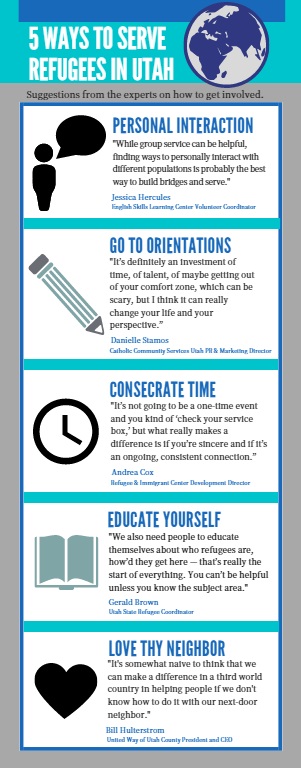
Professionals involved in Utah refugee service suggest unique ways Utahns can currently get involved in serving refugees. (Sarah Averett Harris via Canva)
“We’ve done fun things with them like take them to the aquarium, take them to the Miller Speedway to go up to motorcycle races, taking them swimming,” Ward said. “I would say we do mostly needs, but we occasionally try to hit in on some wants.”
Ward said he finds people in Utah extremely willing to help him in his efforts to serve refugees in the South Salt Lake area.
“After the LDS Church came out at both the Women’s Conference and General Conference, I have far, far more requested things than I could possibly do myself,” Ward said.
Ward said he enjoys serving and learning from the refugees he works with.
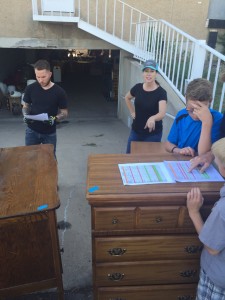
Refugee and Immigrant Center volunteer Tami Schwendiman, center, works with a team of volunteers to deliver furniture to refugees’ homes. (Tami Schwendiman)
“The refugees do so, so, so much for me,” Ward said. “They are just amazing people, and their stories are just heart wrenching when you realize what they’ve been through.”
Broadbent said she feels like volunteers benefit more than clients in serving refugees.
“I would say that from my experience volunteering with refugees, I’m the one that benefits more,” Broadbent said. “I just feel like I’m the one that’s better, and I’m the one that’s changed for good.”
Refugee and Immigrant Center volunteer Tami Schwendiman said working with refugees has made her more aware of how blessed her life is.
“It’s caused me to open my heart more to others,” Schwendiman said. “It has changed my overall outlook on my life.”

Thank you for the informative article. This is an important issue and one that would mean the world to anybody if they were suddenly on the refugee side.